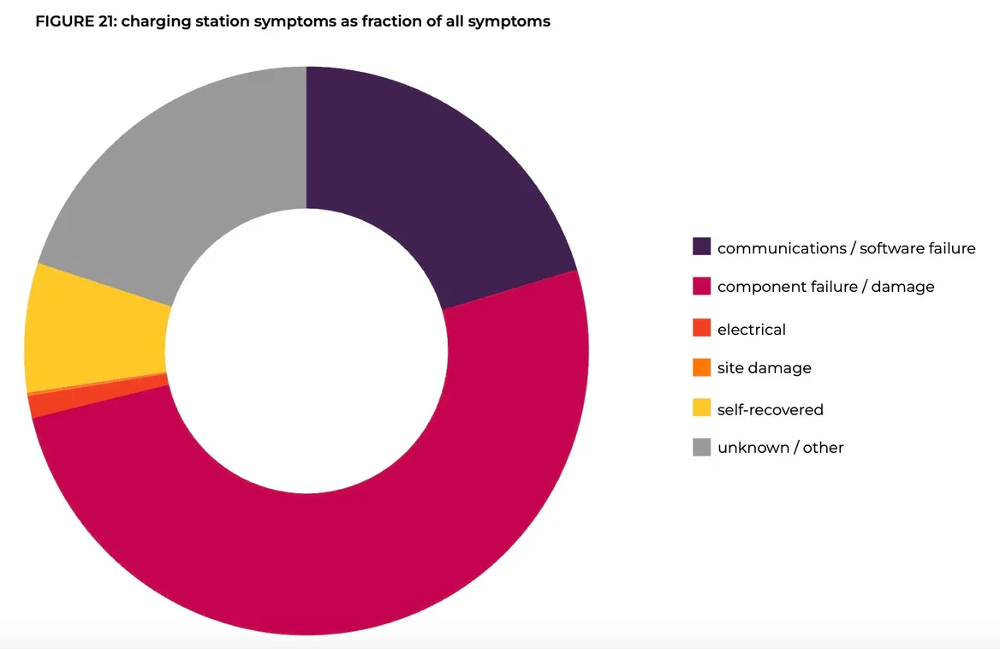Sign up for daily news updates from CleanTechnica on email. Or follow us on Google News!
It should come as no surprise to CleanTechnica readers that tales of faulty EV charging equipment in America are one of the primary factors holding back the EV revolution. We have all heard lurid tales of people who have arrived at an EV charger ready to plug in their electric car, only to find the charger is not operational. That can be highly frustrating, but if you are traveling through South Succotash late at night in a rainstorm with no other charging options available, it can permanently sour you on the whole electric car experience.
People have a way of spreading that kind of bad news around, so soon that story spreads throughout the community of people who might be considering an electric car, and it makes them nervous. The upshot is they become hesitant to take the EV plunge, and so the EV revolution gets slowed down instead of accelerating the way we would like it to. Unreliable public charging infrastructure and inaccurate information on EV charger uptime have become two of the biggest barriers to the EV transition in the US. That’s a problem, as the country needs to shift to EVs fast in order to slash carbon emissions from transportation. But it’s a problem with a clear solution, even if that solution is complicated to implement.
ChargerHelp EV Charger Annual Report
ChargerHelp trains and employs technicians who service and repair EV charging stations in more than a dozen states. Its analysis of more than 19 million data points collected from public and private sources in 2023 — including real-time assessments of 4,800 chargers from ChargerHelp technicians in the field — finds that “software consistently overestimates station uptime, point-in-time status, and the ability to successfully charge a vehicle.”
That doesn’t mean that the technology under the hood of public charging stations is fundamentally broken, Kameale Terry, ChargerHelp CEO and co-founder, told Canary Media recently. But it does mean that players in the EV charging industry have to work together to solve the root causes of the problems. It also means meeting up-time requirements set by state and federal regulators and for EV charger installations supported by public funding programs. “When drivers say the charger doesn’t work, there’s a complex set of reasons why the charger doesn’t work,” Terry said. “It’s not as simple as a gas station. And to fix something that complex, we need to take a more collaborative approach.”
In addition to data from ChargerHelp technicians, the report pulls together information from EV charger data-management provider Paren, the Department of Energy’s Alternative Fuels Data Center, and state utility commission filings. Comparing the data from different sources revealed some significant discrepancies between the automated status reports from the software that manages EV charger installations and what the report describes as “true uptime,” defined as the real life experiences of EV drivers. For example, when ChargerHelp technicians personally inspected 4,800 charge points, they found more than 10% were reported to be online but were in fact unable to complete a test charge.
EV Charger Reliability Is An Issue
Similar discrepancies emerged from Paren, which aggregates data from major US public fast charging stations other than Tesla Supercharger equipment, which is the most reliable charging network available. US charging network providers such as Blink, ChargePoint, Electrify America, and EVgo self-report their EV charger installations are functional 92% of the time, but Paren estimates that true station uptime averages just 84%.
These findings by ChargerHelp are backed up by many smaller scale studies and surveys over the past several years that have found that claims of 95% uptime or greater do not match real world experience. A 2022 study of 657 chargers at 181 non-Tesla public charging sites in the San Francisco Bay Area determined that only 73% were capable of delivering a charge for more than two minutes, for example.
A May survey from Plug In America reported that 40% of US EV drivers expressed dissatisfaction with public charging availability and reliability, and that 68% had experienced a broken or nonfunctional charger within the previous 12 months. A June report from Harvard Business School that analyzed driver reviews of US public EV charger installations reported an average reliability score of 78%.
Terry stressed that driver reviews must be taken with a grain of salt. “Sometimes we see that a driver has a poor experience because of driver error,” she said. “But plenty of problems are beyond the control of drivers, so EV charger network providers need to diagnose and correct problems that lead to failed charging sessions and apps that direct drivers to stations that aren’t working.”
A Lot Of Early EV Chargers Were Junk
The primary US charging networks have responded to the reports of broken and inoperative chargers by replacing older chargers, pledging to repair faulty stations faster, increasing preventative maintenance, and deploying new versions of diagnostic software. Despite all that, improvements have been slow to materialize. In fact, driver satisfaction with public charging has only worsened over the past year, according to the latest J.D. Power Electric Vehicle Experience Ownership Study, released in February. As the variety, price, and range of EVs available to US drivers have become more attractive, mistrust of public charging now constitutes the most significant headwind for EV adoption, J.D. Power says.
“We are starting to see that folks may not want to buy electric vehicles if they only rely on public charging, and that a poor charging experience can deter people from buying an electric vehicle,” Terry said. “The car experience is great — people like electric vehicles. But we have a gap in infrastructure and now we have to come together to figure out what to do about it.”
It’s Complicated

Chargers fail for a number of reasons, but some causes are easier to diagnose and fix than others. Damaged or failing cables or internal electronics can be relatively quickly identified and replaced, and constitute the majority of problems diagnosed by ChargerHelp technicians. But communications, software, and technology integration failures are harder to diagnose, as well as being harder for a technician to resolve on-site since they often require action from charging network operators or their back-end software providers. That means too often the problems preventing successful charging fall into the “unknown” category, which Terry said usually includes payment-processing difficulties — one of the most common reasons for a failed charging session.
Diagnosing what’s going wrong with chargers is complicated by the patchwork nature of the current public charging system. As of this spring, there were more than 175,000 public EV charger locations in the US. Many of them were built by a variety of different companies and are now operated by a number of different charging network providers. All must work with EVs of all makes and models in order to qualify for federal funding. Most EV charger stations must be able to process a bewildering array of payment options, including RFID cards, smartphone apps, credit card readers, and the latest innovation of “plug and charge” systems that rely on onboard EV systems to communicate with chargers.
Software is what makes all of this happen. But different charging stations may be running different versions of software that may or may not integrate with the hardware or payment-processing systems in place. It also may not be up to date with the latest technology standards that provide a more complete array of diagnostic capabilities to determine just what has gone wrong. The ChargerHelp report puts data accessibility and standardization first and second on its list of top priorities for the EV charger industry. “There is a level of data that needs to be exposed, and there needs to be a common definition of uptime,” Terry said.
The Open Charge Point Protocol
Terry said more chargers need to be brought up to date with the latest version of the Open Charge Point Protocol — an open communications protocol that allows different parties in the charging process to share data in a common format. The latest version of OCPP includes far more “error codes” than previous versions and can tell on-site technicians and network operators which pieces of equipment may have malfunctioned or what step in the payment processing has failed.
Training technicians how to identify EV charger issues and solve them is what ChargerHelp does, but Terry says automakers and charging operators need to do a better job of sharing data on how their equipment and software work. “What you need are technicians who understand systems, who understand data, who can help you do QA testing in the field,” she said. “We see new problems every day, with every new EV, or every time a charging provider throws a new firmware update out there.”
The Takeaway
Clearly getting EV charger equipment to work reliably and well is a complex and daunting task. People naturally assume it is similar to pumping gasoline, but it is much more complex than that. There is a whole layer of technological protocols that both the vehicle being charged and the EV charger have to make work before charging can take place. Information on battery state of charge, pack temperatures, and the maximum charging rate needs to be shared and understood at both ends of the charging cable, and that’s before we get into the nuts and bolts of how to pay for a charging session.
In order to succeed, the EV revolution does not necessarily require exactly equal timeframes between filling a gas tank or charging a battery. Most people are willing to make some allowance for new technology, but being able to charge when needed reliably and consistently is something most drivers expect, and deservedly so. With assistance from organizations like ChargerHelp, the EV charging experience is getting better, which will help some drivers who are ambivalent about driving an electric car to conquer their fears and take the EV plunge.
Have a tip for CleanTechnica? Want to advertise? Want to suggest a guest for our CleanTech Talk podcast? Contact us here.
Latest CleanTechnica.TV Videos
CleanTechnica uses affiliate links. See our policy here.
CleanTechnica’s Comment Policy



.jpg)

